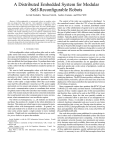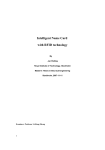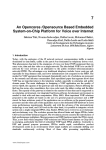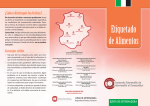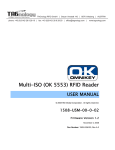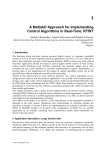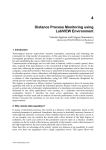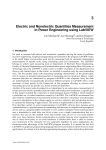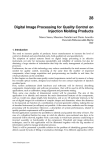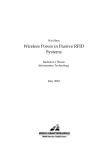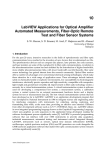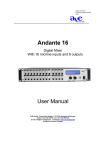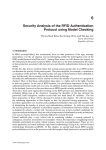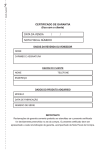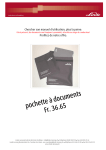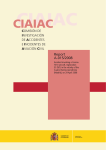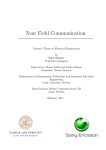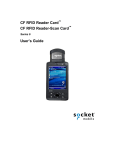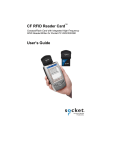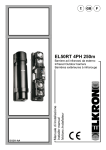Download Use of RFID tags for data storage on quality control in cheese
Transcript
Use of RFID tags for data storage on quality control in cheese industries
213
13
X
Use of RFID tags for data storage on quality
control in cheese industries
Raquel Pérez-Aloe(1), José M. Valverde(1), Antonio Lara(1), Fernando
Castaño(1), Juan M. Carrillo(1), José González(2) and Isidro Roa(2)
Universidad de Extremadura(1). Instituto Tecnológico Agroalimentario(2)
Spain
1. Introduction
The current laws that regulate the food security in the European Union lay down the
principles and general requirements of the food legislation. In the article 3 of the Regulation
178/2002 the traceability is defined as the “ability to trace and follow a food, feed, foodproducing animal or substance intended to be, or expected to be incorporated into a food or
feed, through all stages of production, processing and distribution”. In addition, “the food
traceability must be guaranteed in all the stages described above: production,
transformation and distribution” which implies the obligation of being able of identifying
every product in the company providing a complete information about it (Regulation 178,
2002).
Depending on the activity in the food chain three different types of traceability can be
distinguished:
1) Back traceability, called “suppliers traceability” as well, refers to the possibility of having
knowledge of what products are coming into the company, where are they coming
from as well as which farmers are their suppliers.
2) Internal traceability or “process traceability” refers to the information about what is
made, from what it is made, how and when it is made and the identification of the
product.
3) Forward traceability or “client traceability” means the possibility of knowing what
products the company delivers, when and to whom they have been supplied (Coscarón
et al. 2007; Spanish Agency for Food Security, 2004).
Although the law imposes a generic obligation of traceability, it is not mentioned the way in
which companies can achieve that goal (Decree 1808, 1991; Decree 217, 2004).
Nowadays, the sector of cheese production has no a procedure that exhaustively guarantees
a proper traceability throughout all the fabrication stages. The main problem is the cheese
ripening, done in special chambers as shown in Figure 1. The surrounding conditions in
these rooms, such as humidity, temperature, product handling (turning), mould and flora
growing avoid the individual labeling of the products. Is for this that the production and
quality control are performed by batches and the data storage of the information is done
manually by the company staff.
www.intechopen.com
214
Data Storage
Moreover, if the cheese produced by a specific manufacturer has a Protected Denomination
of Origin (P.D.O.) then the product must satisfy stringent requirements about the milk
(origin, characteristics and preserving) and the elaboration, ripening and physical and
physicochemical characteristics of the final result.
Fig. 1. A traditional ripening chamber
To have an idea, for example, the “Ibores” cheese (Spanish Southwest P.D.O.) has to be
made with milk of mountain goats, with a preservation temperature less than 6º C, a
minimum protein content of 6%, fat around 4%, pH higher than 6,5 and so on. One of the
elaboration steps is the salting , which can be wet or dry, using only sodium chloride. In
case of wet salting, the maximum stay time shall be 24 hours in a saline solution with a
maximum concentration of 20%. Regarding the ripening time, it should be, at least, sixty
days, being the finished product cylindrical with a height from 6 to 9 cm, diameter
comprised between 12 and 15 cm and a weight from 750 to 1200 g. In the most traditional
presentation, the cheese is coated with paprika or smeared with olive oil, appearing diverse
colorations due to different moulds (Order 25/4, 1997). This is only a brief summary of the
conditions that “Ibores" cheeses should meet in order to be qualified as product with P.D.O.
The agency responsible for accrediting the P.D.O. is the Regulatory Board. Usually a
technical expert visits the cheese industry requesting to the manufacturer a collection of data
corresponding to the elaboration process to certify, if appropriate, the guarantee of origin
and quality. Besides, the Regulatory Boards of P.D.O. are recognized as entities of product
certification according to the European Standard EN 45011. This regulation shows in detail
the criteria to be applied by these entities to perform a certification of products reliable and
transparent. For instance, in the document that details the criteria to be evaluated by the
technical staff of the Regulatory Board of P.D.O. “Torta del Casar”, other Spanish Southwest
P.D.O. (Order 11/1, 1999; Order 9/10, 2001; Order 6/5, 2002; Regulation 1491, 2003),
appears that the Regulatory Board lays down a control based on sampling and analysis of
milk and cheese. The results will be used in the development of a set of measurable data
which will serve as basis for the accreditation process and to verify the adequacy of the
dairy industry to the certification system. This system, in fact, is based on a procedure of
self-control that includes several actions to be done by the person in charge of quality
www.intechopen.com
Use of RFID tags for data storage on quality control in cheese industries
215
control in the company. These actions must be the periodic checking, as determined by the
regulations, of the physical, physicochemical, microbiological and organoleptic parameters
of the batches to be issued to the market, having a record of the results (CC/3, 2005; CC/4,
2007).
As it is clear from above, it is desirable that the cheese industry and the Regulatory Board of
P.D.O. interact effectively and efficiently to achieve that the final product reaches the
consumer with full guarantee of its origin, manufacturing process or quality. Therefore the
main objective here will be to join efforts between the dairy companies, in terms of
traceability, and the Regulatory Boards of P.D.O. with respect to their quality systems to
certificate products. In this way, the binomial Company-Regulatory Board would have the
necessary tools (hardware-software) that would enable compliance with current legislation
regarding traceability, as well as a continuous quality improvement thanks to the
optimization of the technological process according to the information obtained,
respectively. The key points here would be the speed on getting the required information,
the time saved and the simplification of tasks that would provide the implemented tool
compared to the manual records of data usually done by both, the employees of the cheese
industry and the technical staff of the Regulatory Board of P.D.O. in charge of the quality
certification.
To achieve this goal, a system which deals with the use of Radio Frequency IDentification
(RFID) has been developed. The RFID is a contactless method for data transfer in object
identification. The transmission of data is carried-out through electromagnetic waves. The
tag (transponder) consists of a microchip, as well as an antenna, which are usually put in
some form of casing for protection against different environments. The RFID read/write
device creates a weak electromagnetic field. If a RFID tag passes this field, the microchip of
the transponder wakes up and can send or receive data without any contact to the reader. If
the tag leaves the field, the communication gets interrupted and the chip on the tag stops
working, but the data on the tag keeps stored (Finkenzeller, 2003). To provide the system
with portability a PDA (Personal Digital Assistant) with reader and embedded antenna can
be used. Figure 2 shows the usual components of a RFID system.
Fig. 2. Usual components of a RFID system
www.intechopen.com
216
Data Storage
There are different RFID technologies available: passive tags have no own power source and
take their energy directly from the magnetic field of the reader. Passive RFID tags do not
need any maintenance, but the reading distance depends on the size and frequency of the
transponder and antenna. Active tags are much more complex than passive tags and have
an internal battery to increase the reading distances. The life time of active tags is limited
through the battery. The semi-passive tags contain a power source, such as a battery, to
power the microchip’s circuitry. Unlike active tags, semi-passive tags do not use the battery
to communicate with the reader. Communication is done in the same manner than passive
tags do. Semi-passive tags might be dormant until activated by a signal from a reader. This
conserves battery power and can lengthen the life of the tag. There are systems with 134
kHz, 125 kHz, 13.56 MHz, 868 MHz, 915 MHz, 2.45 GHz available, having different
properties and reading distances depending on the environmental conditions.
Hence the main characteristics of a RFID system are:
- Communication done without physical contact between the reader and the tags.
- Soil resistant.
- No line of sight required.
- Read/Write memory.
- Possibility to store production and/or product data into the tag´s memory.
- Multi read /write capability.
Obviously, the use in dairy products of these “smart cards or tags” allows obtaining the
benefits that come from the fact of providing the product with a “certain kind of
intelligence”, such as:
- To have only one identity.
- To be able to communicate with his environment in a efficient way.
- To be capable of obtaining and retaining the information about itself.
Also in this context, the RFID solution offers, versus the „traditional” bar code, the
following advantages:
- Huge number of data in a reduced physical space.
- Automatic writing/reading in either individual or by batch mode. This is performed
thanks to the use of anti-collision algorithms, which allow reading several RFID tags
without interferences.
- Bar code needs visibility to work properly and the information stored can not be changed
using the same tag.
- Bar code identifies a type of object. The RFID tag identifies an only object in an only way.
- Bar code is easily damaged in wet environments like are the ripening chambers where
mould growing exists. In this case a RFID tag can be wrapped, for example, by biofilm
without affecting the reading/writing process.
Barcodes are of course cheap to create, but they are limited in their storage capacity and are
not flexible, when data needs to be changed.
Taking into account all the features mentioned above, a system based on the use of RFID
transponders seems to be the most appropriate to carry-out the proposed tasks. The idea is
to use RFID tags as physical support for storing the information required to perform a
“complete traceability” in cheese industries, as well as facilitate the collection of data
required by the technical experts of the Regulatory Boards in charge of quality certification
(Pérez-Aloe et al., 2007). The application will perform the three types of traceability (vendor,
process and customer) and an individual register of analysis and controls done in all the
www.intechopen.com
Use of RFID tags for data storage on quality control in cheese industries
217
production stages (milk reception, storage, fabrication, ripening, quality and yield control
and pH measures) as well. In this way, the collected data corresponding to the process
conditions (humidity, temperature, pressure, ventilation) including microorganism,
biochemical and pH analysis and the connection of these data with the products provided
by the different suppliers are increased. Then, the traceability will be granted, both on
batches and on individual cheeses. This contributes to assure and certificate the quality,
making easier the location, immobilization and in some cases the effective and selective
recall when problems arise.
In this way, the device RFID would operate as an interface making easier and more efficient
the exchange of data and information between the company and the technical staff of the
Regulatory Board of the P.D.O. A sketch of this procedure can be seen in Figure 3.
Company
Regulatory Board
READING
WRITING
WRITING
READING
Diary
manufacturer
Technical staff
RFID tag
Technical staff
P.D.O.
Fig. 3. Use of RFID tags in the integrated system of quality control Company-Regulatory
Boards of P.D.O.
2. System implementation
The system developed is similar to that shown in Figure 2. It consists of two complementary
systems; one is based on a personal computer (PC) and the other in a PocketPC (PPC). The
PocketPC utility was implemented as a complement to the PC due to its portability. The
Figure 4 presents a simplified block diagram of the two systems implemented.
Data to write
User
Data Analysis
Software
Data read
Software
Interface
Hardware
Interface
PPC Platform
CF Module
PC Platform
External
Antenna
+
RS232Reader
Fig. 4. A simplified block diagram of the two systems implemented
www.intechopen.com
RFID
Tags
218
Data Storage
The PC system includes the S6350 midrange reader and the gate antenna series 6000 (Texas
Instruments_RFID, 2002). The reader operates at 13.56 MHz and is able to communicate
with tags that accomplish ISO 15693 protocol. The communication to the reader is done
through a PC serial port, using a RS-232 data transmission protocol, with one start bit, 8 data
bits, 1 stop bit and no parity. Several speeds can be selected within the range from 9600 bps
to 57600 bps. The PC starts the communication with the reader, through a pair of
request/response sequences accomplishing ISO 15693 standard, which establishes the
request stream format as well as the fields size. Some of the commands supported by the
reader can be used with addressing, i.e., read, write and lock. If addressing is used, the
command will be sent to a single tag, and in the other case, the command will be
broadcasted to all tags in the visible range of the reader. For example, Figure 5 shows the
display of the reader utility after sending the command inventory. As it can be seen, as a
response to this command, all transponders visible to the reader appear on the screen.
Fig. 5. Display of the reader utility in response to the command inventory
The system is also able to detect errors in such a way that if an error occurs during the
communication, the reader will send an error code in the response stream to the PC. Some
errors are tags not found in the vision range, a write attempt to a read-only block or an
addressing to a non existing block.
Regarding the PPC system, it consists of:
- PDA with Windows PocketPC 2003® (Hewlett Packard iPAQ, 2003).
- Compact Flash reader with built-in antenna (ACG, 2006).
The hardware interface runs also at 13.56 MHz. Both ASCII and binary transmission modes
are supported by the reader, but only ASCII mode has been developed because it simplifies
the process. The transmission protocol is ASCII mode at 9600 bps. The PocketPC and the PC
version are fully compatible, so that a tag written by one application can be read by the
other without problems. The software was implemented with Microsoft® Embedded Visual
C++ environment, and the source code includes the library supplied by the reader
manufacturer. All the data stored in a tag are accessed and read in just 8 seconds.
www.intechopen.com
Use of RFID tags for data storage on quality control in cheese industries
219
Two different types of labels running at 13,56 MHz have been used in this application:
- Individual tags to be used to identify each cheese.
- Batch tags which store all data set and parameters related to its manufacturing process as
well as information about the cheeses that belong to it.
Besides, two different rounded-shape tags with different sizes have been tested for
individual labels, both on casein plate in order to improve the adherence to the cheese. The
smaller one has a diameter of 9 mm and uses the chip I-Code SL2 ICS20 (Philips
Semiconductors, 2003). The other one consists of a similar chip and has a size of 20 mm
(Labelys, 2007). I-Code chip has a user memory of 128 bytes, divided into blocks of 32x32
bits. Of these 128 bytes, only 108 are addressable bytes (27x32 bits).
The tags HF-I ISO 15963 (Texas Instruments, 2005) have been selected to be utilized as batch
labels due to their characteristics of thinness and flexibility. The tags have a 2 kBs user
memory organized in 64 blocks x 32 bits as shown in Figure 6 (a).
(a)
(b)
Fig. 6. Characteristics of the tags used
(a) Memory organization. (b) List of commands.
Tags can contain read-only data (ROM) and read/write data (R/W). The stored data on
blocks can be locked on factory or by user on an irreversible process, so data can not be
modified any more. In other cases, tags can be reused for future utilizations.
All the tags have a locked field, the individual identification code UID (Unique IDentifier of
the transponder) which is a 64 bits code, provided by the manufacturer and defined in ISO
15693 standard. AFI (Application Family Identifier, such as “transportation”,” finance” …)
www.intechopen.com
220
Data Storage
code allows storing the type of application and DSFID (Data Storage Format IDentifier) the
data format. Both of them are 1 byte blocks.
The HF-I tags commands list is seen in Figure 6 (b). Basically, two modes of reading/writing
tags are available: single and multiple tag operation. In single tag operation, the first action
is to detect a single tag, then the reader identifies the UID, and the subsequent
reading/writing commands are referred exclusively to it. On the other hand, in the multiple
tag operation the information is broadcasted to all the tags in the reader range.
The PPC utility includes routines for data interpretation and the communication protocol
between the compact flash reader and the tags (AGC DLL, 2006). The procedure to establish
communication between both devices and start sending commands is shown in Figure 7 (a).
As it can be seen, the port where the reader is connected has to be detected and opened. If
the port has been opened successfully then the reader is activated and ready to send a set of
commands. Figure 7 (b) details the software code that performs the steps previously
mentioned.
The “writing tag” command consists of 11 bytes in ASCII mode, so that the first two bytes
indicate the address of the block to write, the following 8 bytes are the data to write and the
last byte is the NULL or stop chain with all bits to zero. However, the “reading tag”
command contains only 3 bytes, which refer to the block number to be read and the NULL
byte. Moreover, the reader has a 512 bytes buffer, so once the command is sent and the
reader receives the data, the utility can extract the required word from the buffer. The 512
bytes size allows the hardware to read all the tag blocks. Data are sent to the tags by means
of a software application. This application is easy-to-use, so that any employee of the
Detect serial port
Open a communication device
Open a reader
Send command
Get data
Close a reader
Close a communication device
company of Regulatory Boards will be able to use it without difficulties. company or
Regulatory Boards will be able to use it without difficulties.
// Initialise and open the communication port
presetSettings* settings=new presetSettings();
settings->baudRate =460800;
settings->protocol=0;
// ASCII mode
char puerto[30];
// Detects the PDA port where the // CF reader is connected
RDR_DetectSerialPort(puerto);
www.intechopen.com
Use of RFID tags for data storage on quality control in cheese industries
221
//and check if successful. // Open the port
If //command returns a 0 an error //has
occurred
MessageBox((CString)"Error.",(CString)"Información",MB_OK);
//no need to specify the first //parameter in
ASCII mode
if (RDR_OpenComm(puerto,0,settings)==0){
}else{
}
//If port has been opened //successfully then
activate //the reader
RDR_OpenReader(1,6);
RDR_AbortContinuousRead(); //Stop the continuous
//readout.Reading only on request
(a)
(b)
Fig. 7. Procedure to establish the communication between the reader and tags
(a) Flow diagram. (b) Software code
The routine includes a “format tag option” which stores zeros in all blocks in order the tag
to be reused for future activities. A scheme representing the mode in which data are stored
in the tag memory and the data appearance on the PPC screen can be observed in Figure 8.
Regarding the data to be recorded in the tags, the writing process has to be optimized in
order to store as much as possible cheese production parameters. The fields that will be
saved on tags can contain numerical values (temperature, fat, etc.), alphanumerical values
(type of milk, manufacturer, Batch, batch qualification, etc.) and data concerning key dates
on production (elaboration, reception, ripening, etc.). Numerical data will be codified in
binary, differentiating between integer and decimal part. The number of bits required for
each part depends on the range of values and the precision used. In some cases, a data
manipulation is performed. For example, if a variable varies from 3 to 5, for a value of 4.57,
the integer and the decimal part are codified separately.
Data provided by the factory
Stage 6
Milk Reception
Variable Units Format
Date
Temperature ºC
Data in PPC
Range
00/00/00 01/01/11-31/12/99
00,0
02,0 – 12,0
Fields associated on the tag
Fig. 8. Data recorded in tag and its representation on the PPC screen
Effective range of integer part has only 3 values (3, 4 and 5), and an offset of 3 is subtracted,
so only 2 bits are needed (0 to 2) instead of the 4 bits needed if offset is not considered (0 to
5). On the other hand, alphanumerical values will be stored as a simple database, that is,
assigning a numerical value to each data, i.e., type of milk can contain 4 values: “null”,
www.intechopen.com
222
Data Storage
“cow”, “goat” and “sheep”, that will be linked to numerical values 0, 1, 2 and 3,
respectively.
Once all the fields and its associated number of bits are defined, the next step is to arrange
the whole tag. The purpose is that each stage of the production process will be associated
with a collection of blocks. Around two hundred variables related to the parameters
involved in the different phases of the cheese fabrication can be recorded in a tag. Some of
them appear in Table 1.
Variable
General Data
Range
Product Code
1000-2000
Lot
010111-311299
Volume
500 lts-2500 lts
Pieces
50 uds-300 uds
Fit for consumption?
yes/no
Number of tags
000000-999999
Specific data for the different stages
Reception date
01/01/11-31/12/99
Raw milk supplier
Alphabetical
Tank
Alphanumerical
pH
4,00 upH-7,00 upH
Acidity
13,00 ºD-18,00 ºD
Temperature
02,0 ºC-12,0 ºC
Chemical analysis
Fat
3,00 %- 8,00 %
Protein matter
2.50 %-7,00 %
Lactose
3,00 %- 6,00 %
sodium chloride
0,80 %-2,20 %
Microbiological analysis
Listeria monocytogenes
yes/no
Salmonella spp.
yes/no
Staphylococcus aureus
0-20.000 ufc/gr
Yield control
Lot weight
50,0 kgr-400.0 kgr
Lot yield
4,00-12,00
(Volume/Weight)
Average unit weight
750 gr-1400gr
Control of Clients
Client Reference
Alphanumerical
Order number
1-300/0,80-400
(units/kgr)
Table 1. Some parameters stored in the tags
3. Experimental results
The systems have been tested in the industries that collaborate in this work. Previous to
place the prototypes in the companies, exhaustive tests were done on tags in laboratory in
www.intechopen.com
Use of RFID tags for data storage on quality control in cheese industries
223
order to prove proper working under identical operation conditions than in factory. The
simulated conditions were temperature, humidity, biological contamination, acid corrosion,
ammoniacal gases and immersion on saline solutions, inhibiting substances, sugars, colorant
pigments, preservative substances, oils action (Figure 9 (a)) and mould growing (Figure 9
(b)).
(a)
(b)
Fig. 9. Test on tags in laboratory
(a) Immersion on saline solution, olive oil and paprika. (b) Mould growing.
Besides, physical tests have been also made which include friction and flexibility because in
ripening chambers, cheeses with its corresponding tags are subject to turns, shelving
changes, frictions and personnel manipulations. In all these cases, no significant negative
effects have been reported in communication with tags, with the exception of data reading
with metallic materials in the range of the reader, which reported erroneous reading.
Finally, in order to confirm that tags were suitable to be attached to the products from the
start of the fabrication to the end, the tags were placed on the surface of the cheese at the
www.intechopen.com
224
Data Storage
beginning of the production. As can be seen in Figure 10, which corresponds to photographs
taken at different stages of production, both types of tags used as individual labels remained
(a)
Individual tags
Batch tag
(b)
Batch tag
Individual tags
(c)
Fig. 10. Tags in different stages of production
www.intechopen.com
Use of RFID tags for data storage on quality control in cheese industries
225
(a) Before molding. (b) After pressing. (c) At the end of production attached to the rind of
the cheese until the end of the process without reporting errors in the reading/writing
process. Figure 10 also shows the containers with their batch labels.
Regarding the signal range, for the PC application the system is able to read/write tags
inside a radius of around 20 cm, whereas the PPC reader has a limited range of around 25
mm, in both cases, enough for our purposes.
Finally, Figure 11 displays the way in which data are updated using the PPC system. The
application is user-friendly so that employees of factories in charge of quality control and
technical staff of Regulatory Board of P.D.O. responsible for quality certification could use
the system easily.
Fig. 11. Data update in cheeses with attached RFID tags
4. Conclusion
Two different systems that perform the reading/writing task with RFID tags in a cheese
industry have been implemented. One of them is based on a Personal Computer whereas
the other solution uses a PocketPC providing the application with the required portability.
The main objective has been to make available to the factory the complete traceability of the
products, in individual and by batches mode, as well as to provide the technical staff of
Regulatory Boards of P. D. O. with a tool that facilitates the process of quality certification.
The tags have been tested under different conditions of temperature, humidity, acid
corrosion, ammoniacal gases and immerse in saline solutions with inhibiting substances,
sugars, colorant pigments, preservative substances and oils. Besides, physical tests have
been also made which include friction and flexibility. In all the situations, no significant
negative effects have been reported in communication with tags, excepting for metallic
materials in the range of the reader. Around two hundred variables related to the
parameters involved in the different stages of the cheese production can be stored in the tag,
which improve considerably the quality and yield control of the production plant.
www.intechopen.com
226
Data Storage
5. Acknowledgements
This work has been financially supported by the Ministry of Infrastructures and
Technological Development of the Government of Extremadura, under Grant PDT05A042
and PDT08A041 with the economic assistance of the European Union (FEDER).
6. References
ACG Multi ISO Plug-In Reader, (2006). ACG Identification Technologies, RDHP-0206P0-02
ACG RFID Reader DLL, (2006). User Manual, Rev 1.0, January 2006
Certification Criteria CC/3, (2005), Requirements to be met by the dairy industry, Manual of
quality of the Regulatory Board of P.D.O., Torta del Casar, (4), 1-8, Casar de Cáceres
Certification Criteria CC/4, (2007), Characteristics of the "Torta del Casar" Produced. Manual
of quality of the Regulatory Board of P.D.O., Torta del Casar, (5), 1-6, Casar de Cáceres
Coscarón, C.; Gil, M. & Legaz, E. (2007). Revista Alimentaria, No. 383, May 2007, 48-55, ISSN
03005755
Decree 1808, (1991) Which governs the indications or marks identifying the batch to which a
foodstuff belongs
Decree 217, (2004), Which regulate the identification and registration of staff, facilities and
containers involved in the dairy sector, and record the movements of the milk
Finkenzeller, K. (2003). RFID Handbook: Fundamentals and Applications in contactless smart
cards and identification, John Wiley and Sons, ISBN 0-470-84402-7
Hewlett Packard iPAQ h5550 with Windows Pocket PC, (2003)
Labelys traçabilité, (2007). RFID casein plate
Order 25/4, (1997). Laying down the regulations of the Denomination of Origin “Ibores
cheese” and its Regulatory Board
Order 11/1, (1999). Official recognition of the Designation of Origin "Torta del Casar"
Order 9/10, (2001). Adoption of the Rules of the Designation of Origin "Torta del Casar"
Order 6/5, (2002). Ratification of the Rules of the Designation of Origin "Torta del Casar"
Pérez-Aloe, R.; Valverde, J. M.; Lara, A; Carrillo, J. M.; Roa, I. & González, J. (2007).
Application of RFID tags for the overall traceability of products in cheese
industries, Proceedings of 1st Annual RFID Eurasia Conference, pp. 268-272, ISBN 978975-01566-0-1, Turkey, September 2007, Istanbul
Philips Semiconductors, (2003). I-Code SL2 ICS20, Smart Label IC, Rev. 3.0, January 2003
Regulation 178, (2002). Laying down the principles and requirements of food law,
establishing the European Food Safety Authority and laying down procedures
relating to food safety
Regulation 1491, (2003). Registration of Protected Designation of Origin "Torta del Casar" in
the Register of Protected Designations of Origin and Protected Geographical
Indications
Spanish Agency for Food Security (2004). Guide for the application of traceability in food
companies. Coimán S. L., NIPO 355-04-001-9, Madrid
Texas Instruments_RFID, (2002). HF Reader System Series 6000, S6350 Midrange Reader
Module, September 2002
Texas Instruments_RFID, (2002). HF Reader System Series 6000, Gate Antenna, September 2002
Texas Instruments, (2005). Tag-itTM HF-I Plus Transponder Inlays, December 2005
www.intechopen.com
Data Storage
Edited by Florin Balasa
ISBN 978-953-307-063-6
Hard cover, 226 pages
Publisher InTech
Published online 01, April, 2010
Published in print edition April, 2010
The book presents several advances in different research areas related to data storage, from the design of a
hierarchical memory subsystem in embedded signal processing systems for data-intensive applications,
through data representation in flash memories, data recording and retrieval in conventional optical data
storage systems and the more recent holographic systems, to applications in medicine requiring massive
image databases.
How to reference
In order to correctly reference this scholarly work, feel free to copy and paste the following:
Raquel Perez-Aloe, Jose M. Valverde, Antonio Lara, Fernando Castano, Juan M. Carrillo, Jose Gonzalez and
Isidro Roa (2010). Use of RFID Tags for Data Storage on Quality Control in Cheese Industries, Data Storage,
Florin Balasa (Ed.), ISBN: 978-953-307-063-6, InTech, Available from: http://www.intechopen.com/books/datastorage/use-of-rfid-tags-for-data-storage-on-quality-control-in-cheese-industries
InTech Europe
University Campus STeP Ri
Slavka Krautzeka 83/A
51000 Rijeka, Croatia
Phone: +385 (51) 770 447
Fax: +385 (51) 686 166
www.intechopen.com
InTech China
Unit 405, Office Block, Hotel Equatorial Shanghai
No.65, Yan An Road (West), Shanghai, 200040, China
Phone: +86-21-62489820
Fax: +86-21-62489821
















